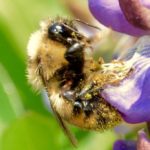Reading Time: 3 minutes The honey produced by the tireless work of the honeybee is nothing short of an untapped goldmine of environmental data that could help us better understand the spread of environmental pollutants.

COMMENT: How honeybees can help us monitor pollution across Canada

Washington state eradicates first ‘murder hornet’ nest of the year
Nest found in northwestern county near B.C. border
Reading Time: 2 minutes Reuters — Washington state eradicated its first Asian giant hornet nest of the year by vacuuming out 113 worker hornets and removing bark and decayed wood near the nest, Washington State Department of Agriculture (WSDA) officials said Thursday. The so-called stinging “murder hornets,” the world’s largest hornets, can grow to five centimetres in length and […] Read more

Less mowing, more flowers, more yield
A few tweaks to farm landscape management can improve life for beneficial insects
Reading Time: 6 minutes It’s estimated that insects such as bees are responsible for pollinating almost 20 per cent of Canada’s crop, but that’s not the only reason for protecting their habitat. It’s also a breeding ground for beneficial insects that prey on cereal, oilseed and pulse crops. A recently completed study shows that simply “tweaking” agronomic practices can […] Read more

Two neonics set for three-year extensions on registration
Reading Time: 3 minutes Health Canada’s pesticide regulator proposes to allow continued registration for two members of the neonicotinoid family of pesticides, both of which are under heavy scrutiny for their effects on bees and other pollinators. The Pest Management Regulatory Agency on Tuesday issued proposed decisions on clothianidin and thiamethoxam that would extend the products’ existing conditional registrations […] Read more

U.S. bee numbers growing
Reading Time: < 1 minute CNS Canada – Honeybee populations are rising in the United States, turning around a recent trend of declines attributed to a set of factors know as colony collapse disorder. It’s estimated that 84,430 hives were lost to the disorder in the first quarter this year. That’s down 27 per cent from a year earlier. Year-over-year […] Read more

ALUS program expands to Quebec
Reading Time: 2 minutes The Alternative Land Use Services (ALUS) program has made its move into a sixth province with a new project in Quebec’s Monteregie. ALUS Canada, working with the Monteregie branch of Quebec’s Union des producteurs agricoles (UPA), formally launched the program Wednesday at its first Quebec location, a farm near St-Jean-Baptiste, south of St-Hyacinthe. ALUS, in […] Read more

Regulatory reviews show slim risk to bees from imidacloprid
Reading Time: 4 minutes Label directions and rules for foliar and on-seed use of imidacloprid pesticides should either prevent or limit the risks to honeybees and other pollinators from the chemical, Canadian and U.S. regulators say in a new early-stage risk assessment. Health Canada’s Pest Management Regulatory Agency (PMRA) and the U.S. Environmental Protection Agency (EPA) on Wednesday released […] Read more

Wild bees seen dwindling in main U.S. crop regions
Reading Time: 2 minutes Washington | Reuters — Wild bees, crucial pollinators for many crops, are on the decline in some of the main agricultural regions of the U.S., according to scientists who produced the first national map of bee populations and identified numerous trouble spots. The researchers on Monday cited 139 counties as especially worrisome, with wild bee […] Read more

Quebec heading toward neonic limits on crops
Reading Time: 4 minutes The Quebec government is preparing consultations ahead of a wide legislative swath through the province’s pesticide sector, to limit farmers’ use of neonicotinoid insecticide seed treatments and certain other pesticides. Environment Minister David Heurtel on Sunday released the province’s pesticide strategy for 2015 to 2018, mapping out the Couillard government’s plans in those years to […] Read more

Study of bumblebee decline points to climate ‘vise’
Reading Time: 4 minutes A study of the shrinking range of bumblebee habitat suggests farmers relying on those species to pollinate crops may soon have to look elsewhere, barring a reversal of climate change — or, perhaps, an “assisted migration.” An international study of specimens from 31 species of bumblebees in North America and 36 such species in Europe, as […] Read more


